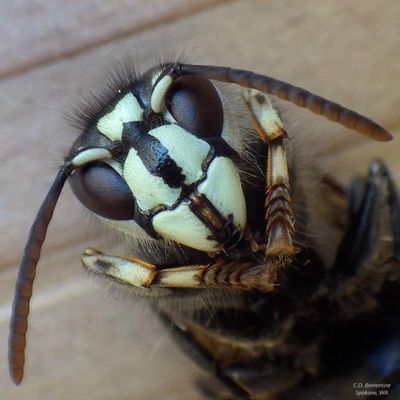Bugging the Northwest: Bald-faced hornets are bullish but beneficial

The bald-faced hornet isn’t really a hornet. Instead, it’s a yellow jacket. And it just so happens to be the largest type of yellow jacket in the Pacific Northwest, even though it’s not yellow.
Confused yet?
“It is mistakenly called a hornet because of its larger size and distinctive coloration, said entomologist Richard Zack of Washington State University. “The name comes from the distinctive white of the face,” he said.
About that face. In the close-up picture accompanying today’s column, photographed in Spokane a few weeks ago, you can see that its black and ivory-white markings give it a mask-like appearance. In fact, it resembles the Guy Fawkes mask popularized by the movie “V is for Vendetta” and now used as an emblem for social protest.
Scientifically called Dolichovespula maculata, this fearsome-looking critter is not best known for its face – which we seldom see up close – but for the nest it builds. We’ve all seen those gray papier-mache-like objects hanging in trees or shrubs. The size of a football and similarly shaped, they are most visible after the leaves fall from trees in autumn.
But the bald-faced hornets themselves are most visible right now, said Zack. “They tend to be more aggressive than our other yellow jacket species and their sting can be painful,” he explained. “Late summer and early fall are the most problematic.”
As with any yellow jacket species, the bigger bald-faced hornets will sting repeatedly to defend themselves and their nest. Therefore, the secret to not getting stung is to not tick them off.
The good news is, even though bald-faced hornets are more aggressive and their sting is more painful, they’re typically not as bothersome as other yellow jacket species, Zack said. First off, they’re more interested in eating live prey such as caterpillars than sampling our grilled hamburgers and soft drinks.
So the trick is to stay away from their nests, he advised. Fortunately, since the insects usually build them high up in trees and shrub branches, it’s not that hard to do. As you may have painfully discovered, that’s not the case with most run-of-the-mill yellow jackets, who build their nests in the ground and are more likely to sting you for simply walking by.
Bald-faced hornet colonies are at their largest size this time of year, with upwards of 500 workers in each nest, said Zack, adding that there’s an uptick in numbers this September. “For some reason, this seems to be a year in which the bald-faced hornet is more common,” he said.
Despite their painful stings and sinister looks, bald-faced hornets are considered beneficial, killing pests such as caterpillars, aphids, sawflies and other wasps. They are also pollinators.
If there’s a nest, it’s out of the way and you can tolerate it, then let it be, said Zack. But if it’s in an area where there’s a chance of the wasps being agitated by children, pets or other activities, have a pest control specialist remove it, he said. If you can’t afford it, then purchase a spray that kills wasps and hornets. Should you go that DIY route, “read all of the instructions on the container and be careful,” he said.